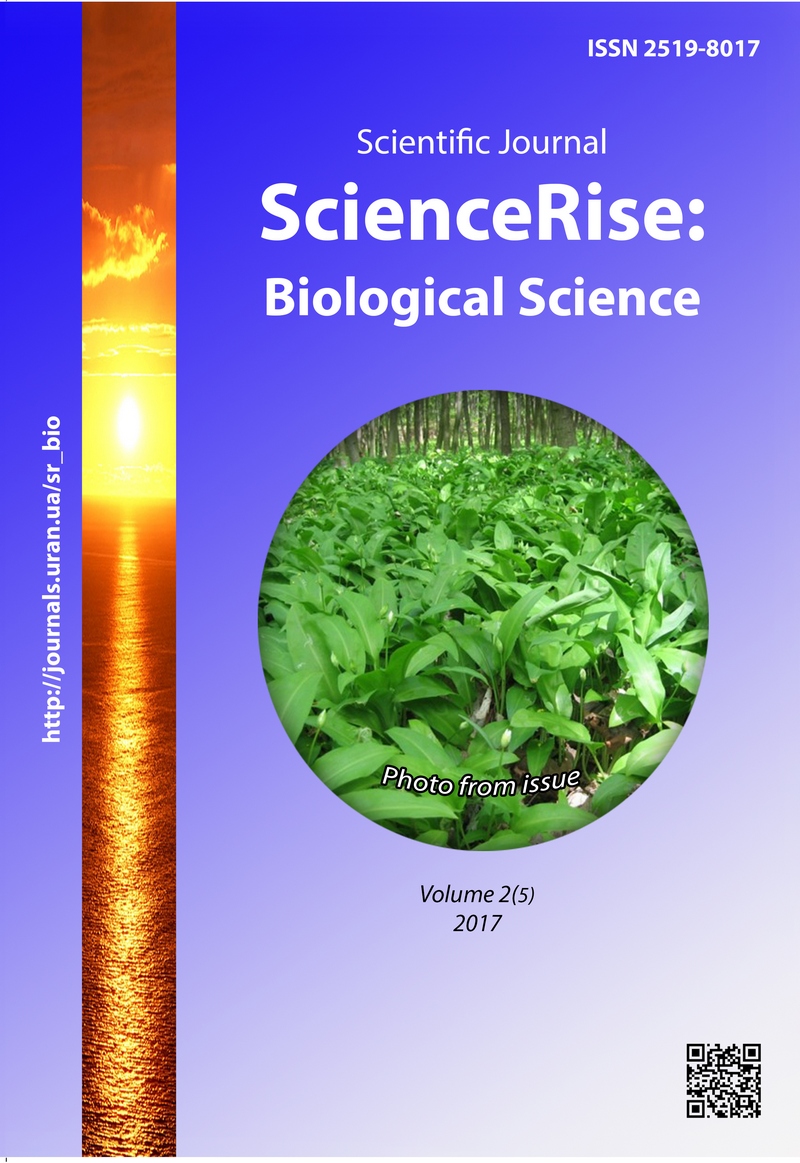Analysis of morphological changeability of sardelle (clupeonella cultriventris, nordmann, 1840) of Dnipro-Bugh mouth system
DOI:
https://doi.org/10.15587/2519-8025.2017.98792Keywords:
Dnipro-Bugh mouth system, sardelle, meristic, plastic signs, morphological changeabilityAbstract
The regulation of the natural channel of Dnipro, which beginning took place in the first half of fifties of previous century, caused the cardinal worsening of hydrobiocenosis condition of Dnipro-Bugh mouth system. The transformational processes that last till today are attended with the changes of main biological characteristics of ichthyocenosis, where sardelle - Clupeonella cultriventris (Nordmann, 1840) was always the most numerous representative of herring.
In this connection the aim of research was formed – to analyze the main morphological features of sardelle from Dnipro-Bugh mouth system under modern conditions, to compare them with the literary data of previous century and to trace the possible changes of body proportions in time. At that the certain attention was paid to detection of sex dimorphism in herd.
For attaining the set aim, the correspondent volume of scientific-research works was carried out using the methods and instructions, generally recognized in ichthyological practice. The morphological changeability was determined by Student t-criterion (td) taking into account the actual volume of sampling (n)and significance level (р<0,05).
The analysis of meristic signs of sardelle demonstrated that the fin formulas are the following: D – ІІІ-ІV (М=3,46±0,06) 7-12 (М=9,67±0,18); A – ІІІ-ІV (М=3,44±0,06) 10-18 (М=13,06±0,22); P - 11-17 (М=13,17±0,16); V – 6-11 (М=8,60±0,15); С ІІ (IV) (М=2,09±0,05) 19-26 (М=21,93±0,16), and the number of abdominal spinules is 24—28 (М=25,94±0,16).
It was established, that the most essential changes of body proportions in sardelle in the process of Dnipro channel transformation take place by the indices of anteventral distance (td=10,06; р<0,05) and breast fins length(td=10,99; р<0,05). The existence of sex dimorphism in herd was proved. Among 20 analyzed plastic signs the reliable difference was revealed by 12 indices, but it was more significant by the most body height, antepectral distance and abdominal fins length – td=4,5-6,8 (р<0,05)
References
- Sherman, І. M., Gejna, K. M., Kutіshchev, S. V., Kutіshchev, P. S. (2013). Ekologіchnі transformacіi rіchkovih gіdroekosistem ta aktual'nі problemi ribnogo gospodarstva. Ribogospodars'ka nauka Ukrainy, 4, 5–16.
- Grinzhevskiy, M. V. (1998). Akvakultura Ukrayini (organizatsiyno-ekonomichni aspekti). Lviv: Vilna Ukrayina, 364.
- Kozlov, V. I. (1993). Ekologicheskoe prognozirovanie ihtiofauny presnyh vod. Moscow: VNIRO, 250.
- Siginevich, G. P. (1968). Otsenka zapasov tyulki i stepeni ispolzovaniya eyu zooplanktona Kahovskogo vodohranilishcha. Gidrobiologicheskiy zhurnal, 4 (5), 46–54.
- Spiropulo, Z. I. (1981). Pitanie i pishchevye vzaimootnosheniya molodi promyshlennyh ryb v nizovyah Dnepra. Rybnoe hozyaystvo, 32, 58–62.
- Luts, G. I., Mihman, A. S., Rogov, S. F., Filchagin, N. K. (1981). Pitanie azovskih pelagicheskih ryb tyulki i hamsy. Gidrobiologicheskiy zhurnal, 17 (4), 26–31.
- Kogan, A. V., Zaytseva, E. M. (1974). Pitanie tyulki Clupeonella delicatula caspia morpha tscharchalensis (Borodin) Kuybyshevskogo vodohranilishcha. Voprosy ihtiologii, 14 (3 (86)), 477–482.
- Ozinkovskaya, S. P. (1969). Razmnozhenie tyulki v Kahovskom vodohranilishche. Kishinev, 28.
- Siginevich, G. P. (1969). Tyulka (Clupeonella delicatula delicatula NORDMANN) kak planktofag Kahovskogo vodohranilishcha. Leningrad, 21.
- Shevchenko, P. G. (1991). Ekologo-morfologicheskaya harakteristika tyulki Clupeonella cultriventris cultriventris (Nordman) i ee rol v ekosisteme dneprovskih vodohranilishch. Kyiv, 18.
- Geyna, K. M. (2007). Harchovi vzaemovidnosini tyul'ki ta tovstolobikiv Kahovskogo vodoshovishcha. Institut ribnogo gospodarstva UAAN. Kyiv, 24.
- Geyna, K. M., Gorbonos, V. M. (2006). Rozmirno-vagova ta vikova struktura populyatsiyi tyul'ki Dniprovsko-Buzkoyi girlovoyi sistemi u zv’yazku z osoblivostyami vedennya yiyi promislu. Prirodnichiy almanah, 8, 18–26.
- Vladimirov, V. I. (1950). Tyulka basseyna r. Dnestr. Trudy instituta gidrobiologii, 25, 63.
- Pravdin, I. F. (1966). Rukovodstvo po izucheniyu ryb. Moscow: Pishchevaya promyshlennost, 374.
- Aksyutina, Z. M. (1968). Elementy matematicheskoy otsenki rezultatov nablyudeniy v biologicheskih i rybohozyaystvennyh issledovaniyah. Moscow: Pishchevaya promyshlennost, 289.
- Pavlov, P. Y. (1980). Fauna Ukrayini. Ribi. Lichinkohordovi (astsidiyi, apendikulyariyi), bezcherepni (golovohordovi) hrebetni (krugloroti, hryashchovi ribi, kistkovi ribi – osetrovi, oseledtsevi, anchousovi, lososevi, hariusovi, shchukovi, umbrovi). Vol. 8. Kyiv: Naukova dumka, 352.
Downloads
Published
How to Cite
Issue
Section
License
Copyright (c) 2017 Konstantin Gеіna, Svetlana Shashlykova

This work is licensed under a Creative Commons Attribution 4.0 International License.
Our journal abides by the Creative Commons CC BY copyright rights and permissions for open access journals.
Authors, who are published in this journal, agree to the following conditions:
1. The authors reserve the right to authorship of the work and pass the first publication right of this work to the journal under the terms of a Creative Commons CC BY, which allows others to freely distribute the published research with the obligatory reference to the authors of the original work and the first publication of the work in this journal.
2. The authors have the right to conclude separate supplement agreements that relate to non-exclusive work distribution in the form in which it has been published by the journal (for example, to upload the work to the online storage of the journal or publish it as part of a monograph), provided that the reference to the first publication of the work in this journal is included.









